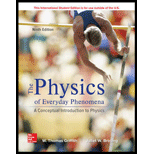
A merry-go-round in the park has a radius of 1.5 m and a rotational inertia of 800 kg·m2. A child pushes the merry-go-round with a constant force of 92 N applied at the edge and parallel to the edge. A frictional torque of 14 N·m acts at the axle of the merry-go-round.
- a. What is the net torque acting on the merry-go-round about its axle?
- b. What is the rotational acceleration of the merry-go-round?
- c. At this rate, what will the rotational velocity of the merry-go-round be after 16 s if it starts from rest?
- d. If the child stops pushing after 16 s, the net torque is now due solely to the friction. What then is the rotational acceleration of the merry-go-round? How long will it take for the merry-go-round to stop turning?
(a)
The net torque acting on the merry –go-round about its axle.
Answer to Problem 1SP
The net torque acting on the merry-go-round is
Explanation of Solution
Given info: Radius is
Write the expression for the net torque.
Here,
Substitute
The net torque acting on the merry-go round is given by subtracting from the frictional torque.
Conclusion:
Therefore, the net torque acting on the merry-go-round is
(b)
The rotational acceleration of the merry-go-round.
Answer to Problem 1SP
The rotational acceleration of the merry-go-round is
Explanation of Solution
Write the expression for the rotational acceleration.
Here,
Substitute
Conclusion:
Therefore, the rotational acceleration of the merry-go-round is
(c)
The rotational velocity of the merry-go-round after
Answer to Problem 1SP
The rotational velocity of the merry-go-round will be
Explanation of Solution
Write the expression for the rotational velocity.
Here,
Substitute
Conclusion:
Therefore, the rotational velocity of the merry-go-round will be
(d)
Rotational acceleration of the merry-go-round and the time taken for the merry-go-round to stop running.
Answer to Problem 1SP
The rotational acceleration will be
Explanation of Solution
The net torque is only due to the friction.
Write the expression for the rotational acceleration.
Substitute
Write the expression for the rotational velocity.
Rearrange the above equation to find
Substitute
Conclusion:
Therefore, rotational acceleration will be
Want to see more full solutions like this?
Chapter 8 Solutions
Physics of Everyday Phenomena
- pls help on thesearrow_forward20. Two small conducting spheres are placed on top of insulating pads. The 3.7 × 10-10 C sphere is fixed whie the 3.0 × 107 C sphere, initially at rest, is free to move. The mass of each sphere is 0.09 kg. If the spheres are initially 0.10 m apart, how fast will the sphere be moving when they are 1.5 m apart?arrow_forwardpls help on allarrow_forward
- 19. Mount Everest, Earth's highest mountain above sea level, has a peak of 8849 m above sea level. Assume that sea level defines the height of Earth's surface. (re = 6.38 × 106 m, ME = 5.98 × 1024 kg, G = 6.67 × 10 -11 Nm²/kg²) a. Calculate the strength of Earth's gravitational field at a point at the peak of Mount Everest. b. What is the ratio of the strength of Earth's gravitational field at a point 644416m below the surface of the Earth to a point at the top of Mount Everest? C. A tourist watching the sunrise on top of Mount Everest observes a satellite orbiting Earth at an altitude 3580 km above his position. Determine the speed of the satellite.arrow_forwardpls help on allarrow_forwardpls help on allarrow_forward
- 6. As the distance between two charges decreases, the magnitude of the electric potential energy of the two-charge system: a) Always increases b) Always decreases c) Increases if the charges have the same sign, decreases if they have the opposite signs d) Increases if the charges have the opposite sign, decreases if they have the same sign 7. To analyze the motion of an elastic collision between two charged particles we use conservation of & a) Energy, Velocity b) Momentum, Force c) Mass, Momentum d) Energy, Momentum e) Kinetic Energy, Potential Energyarrow_forwardpls help on all asked questions kindlyarrow_forwardpls help on all asked questions kindlyarrow_forward
 University Physics Volume 1PhysicsISBN:9781938168277Author:William Moebs, Samuel J. Ling, Jeff SannyPublisher:OpenStax - Rice University
University Physics Volume 1PhysicsISBN:9781938168277Author:William Moebs, Samuel J. Ling, Jeff SannyPublisher:OpenStax - Rice University Glencoe Physics: Principles and Problems, Student...PhysicsISBN:9780078807213Author:Paul W. ZitzewitzPublisher:Glencoe/McGraw-Hill
Glencoe Physics: Principles and Problems, Student...PhysicsISBN:9780078807213Author:Paul W. ZitzewitzPublisher:Glencoe/McGraw-Hill Physics for Scientists and Engineers: Foundations...PhysicsISBN:9781133939146Author:Katz, Debora M.Publisher:Cengage Learning
Physics for Scientists and Engineers: Foundations...PhysicsISBN:9781133939146Author:Katz, Debora M.Publisher:Cengage Learning College PhysicsPhysicsISBN:9781285737027Author:Raymond A. Serway, Chris VuillePublisher:Cengage Learning
College PhysicsPhysicsISBN:9781285737027Author:Raymond A. Serway, Chris VuillePublisher:Cengage Learning College PhysicsPhysicsISBN:9781938168000Author:Paul Peter Urone, Roger HinrichsPublisher:OpenStax College
College PhysicsPhysicsISBN:9781938168000Author:Paul Peter Urone, Roger HinrichsPublisher:OpenStax College Principles of Physics: A Calculus-Based TextPhysicsISBN:9781133104261Author:Raymond A. Serway, John W. JewettPublisher:Cengage Learning
Principles of Physics: A Calculus-Based TextPhysicsISBN:9781133104261Author:Raymond A. Serway, John W. JewettPublisher:Cengage Learning





